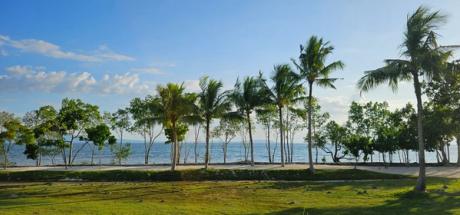
Manila-based art gallery Silverlens is launching an artist residency on an island in the southern Philippines, where residents will use found materials to create public art installations.
The Lubi Art Residency takes its name from the Visayan word for coconut and is held at the Dusit Thani Lubi Plantation Resort on Kopiat Island in the Davao Gulf, which until the 1990s was largely agricultural. Artists will use materials from the island like driftwood, bamboo and debris washed ashore for installations that will be allowed to deteriorate over time, making their projects during the residency carbon-neutral.
“In Southeast Asia, our lives revolve around the environment: storms, earthquakes and volcanoes. There is respect for nature, because we are the first hit,” says Rachel Rillo, one of the gallery’s two co-owners. “Because we live in the islands, we know that nothing is permanent. Things will degrade, they will rot because of humidity and storms or the heat of the sun. Things will eventually return to nature.”
Using recovered materials from the island isn’t only carbon-neutral, it’s also pragmatic, minimising the need for costly shipping to and from the island. Silverlens selected artists who already use found objects as part of their practices, says Isa Lorenzo, the other co-owner. The first cohort of artists includes Corinne de San Jose, Gary-Ross Pastrana, Wawi Navarroza, Christina Quisumbing Ramilo, Bernardo Pacquing and James Clar.
The artists’ work is expected to be completed by the end of the year, and installed in public spaces around the island by March 2024. For the residency, Silverlens partnered with the Lanang Realty Development Corporation, the group that has helped preserve the island’s biodiversity and brought in local scientists and marine biologists to protect the area from erosion. The Davao Gulf is home to one of the most diverse cetacean habitats in the Philippines, and the island’s beaches serve as a turtle sanctuary. Ecotourism has also provided an economic boost for the region.
Rillo and Lorenzo were inspired to start their own residency by similar programmes in Naoshima, Japan, an island where once-abandoned fishing villages have been revitalised by contemporary art spaces, they said. One unique challenge was incorporating the local community in the residency when traditional art institutions are less commonplace in the country.
“Here in the Philippines and a lot of developing Southeast Asian countries, we don’t have a lot of museums and we don’t have a lot of infrastructure for art. But we are big on festivals, music, performances, beauty and decorating,” Rillo says. “Which is great, because the introduction to art can be experience-based. It can be something you walk into.”
When Lorenzo first started visiting Kopiat Island three decades ago, the beach stretched along for about eight metres before hitting the water. Now, as a result of climate change and erosion, there’s no natural beach at all, and a breakwater has been installed around much of the island, Lorenzo said. Cyanide fishing was also once a popular method for collecting fish around the island, which damaged the local underwater flora and fauna, including coral reefs. But since becoming a protected area, the local ecosystem has flourished again.
“Yes, climate change is happening. But at the same time, there’s still things that you can do to save the environment,” Lorenzo says. “Just leave it alone and it will regenerate.”
“It takes so little for the environment to grow on its own,” Rillo adds.
Silverlens, which Lorenzo founded in Manila in 2004 before Rillo came onboard in 2007, opened a New York location in Chelsea last year.










